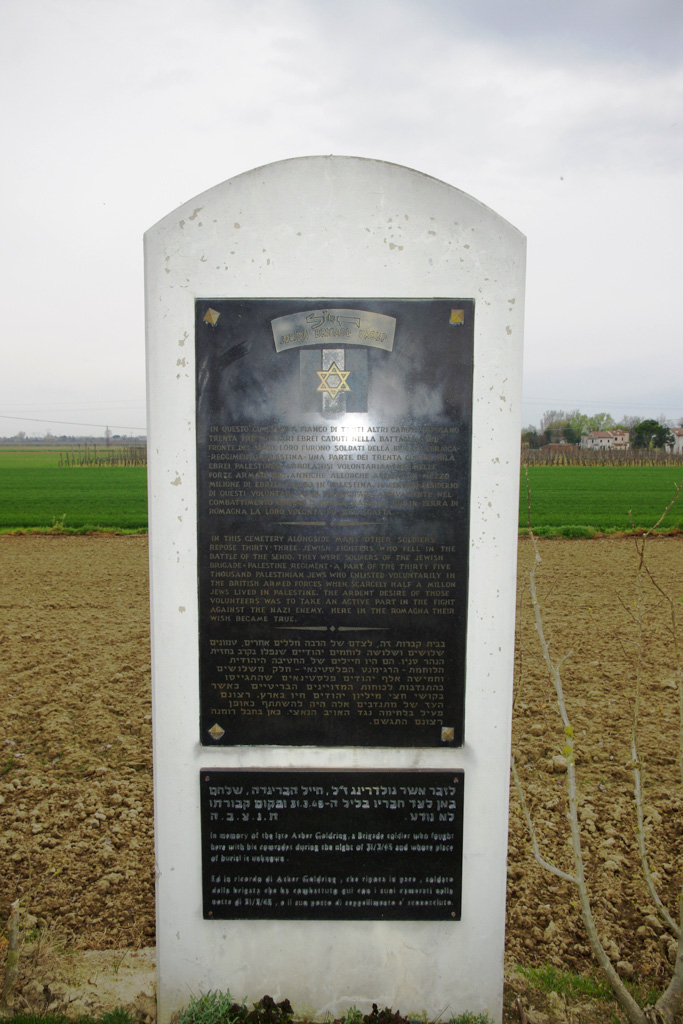
Posizione
- Nazione:
- Italia
- Indirizzo:
- Via Piangipane
- CAP:
- 48124
- Latitudine:
- 44.44185000455401
- Longitudine:
- 12.107763809332255
Informazioni
- Luogo di collocazione:
- Nella campagna di Piangipane, a nord ovest di Ravenna.
- Data di collocazione:
- Realizzato nell’immediato dopoguerra (data precisa sconosciuta)
- Materiali (Generico):
- Laterizio, Marmo, Pietra
- Materiali (Dettaglio):
- Le centinaia di lapidi sono in marmo e riportano incisi i nomi e l’età dei caduti. Sono presenti anche una croce in pietra alta diversi metri, una cappella in muratura contenente materiale informativo affisso alle pareti e il libro dei visitatori. La stele in ricordo dei trentatre ebrei sepolti nel cimitero è in marmo bianco e supporta una lastra di marmo nero con le iscrizioni incise.
- Stato di conservazione:
- Ottimo
- Ente preposto alla conservazione:
- Commonwealth War Graves Commission
- Notizie e contestualizzazione storica:
- Tra l’estate del 1943 alla primavera del 1944 il fronte della guerra interessò il territorio romagnolo. L’VIIIa Armata del maresciallo britannico Alexander, costituita da contingenti di 26 nazioni, dal Canada all’India, dalla Polonia al Brasile, fronteggiò le truppe nazifasciste, grazie all’aiuto decisivo delle formazioni partigiane e all’appoggio della popolazione. Dalla battaglia di Rimini, alla battaglia di Ravenna, alla battaglie delle Valli fino alla liberazione di Alfonsine, furono migliaia le vittime civili e militari del conflitto.
FONTE: http://www.cwgc.org/find-a-cemetery/cemetery/70505/RAVENNA%20WAR%20CEMETERY
On 3 September 1943 the Allies invaded the Italian mainland, the invasion coinciding with an armistice made with the Italians who then re-entered the war on the Allied side.
Following the fall of Rome to the Allies in June 1944, the German retreat became ordered and successive stands were made on a series of defensive lines. In the northern Appenine mountains the last of these, the Gothic Line, was breached by the Allies during the Autumn campaign and the front inched forward as far as Ravenna in the Adratic sector, but with divisions transferred to support the new offensive in France, and the Germans dug in to a number of key defensive positions, the advance stalled as winter set in.
Ravenna was taken by the Canadian Corps at the beginning of December 1944, and the burials in the cemetery there reflect the fighting for the Senio line and the period of relative quiet during the first three months of 1945. Many of the men buried there were Canadians; one of the last tasks of the Canadian Corps before being moved to north-west Europe was the clearing of the area between Ravenna and the Comacchio lagoon. Others are Indians from the 10th Indian Division, and New Zealanders. The site for the cemetery was selected by the Army in 1945 for burials from the surrounding battlefields.
Ravenna War Cemetery contains 955 Commonwealth burials of the Second World War, 63 of them unidentified. There are also 33 First World War burials, 30 of them brought in from Gradisca Communal Cemetery in 1973, the others from communal cemeteries at Arzigano, Fano and Monterosso al Mare. Among those buried in the cemetery are 33 men of the Jewish Infantry Brigade Group which was formed in September 1944, chiefly by volunteers from Palestine; the burials at Ravenna form the largest concentration of casualties from the Brigade.
There is 1 Merchant Seaman whose death is not attributable to war service and 1 French burial.
Contenuti
- Iscrizioni:
- Nella stele dedicata ai 33 soldati della brigata ebraica ci sono iscrizioni nelle lingue italiana, inglese ed ebraica.
IN QUESTO CIMITERO A FIANCO DI TANTI ALTRI CADUTI RIPOSANO TRENTATRE MILITARI EBREI CADUTI NELLA BATTAGLIA SUL FRONTE DEL SENIO. LORO FURONO SOLDATI DELLA BRIGATA EBRAICA – REGGIMENTO PALESTINA – UNA PARTE DEI TRENTACINQUE MILA EBREI PALESTINESI ARRUOLATISI VOLONTARIAMENTE NELLE FORZE ARMATE BRITANNICHE ALLORCHE APPENA UN MEZZO MILIONE DI EBREI VISSERO IN PALESTINA. IL FERVIDO DESIDERIO DI QUESTI VOLONTARI FU DI PARTECIPARE ATTIVAMENTE NEL COMBATTIMENTO CONTRO IL NEMICO NAZISTA. QUI IN TERRA DI ROMAGNA LA LORO VOLONTA’ FU SODDISFATTA.
- Simboli:
- Nella stele è presente il simbolo della Brigata Ebraica (la stella di David con la bandiera italiana sullo sfondo) sormontata dalla scritta JEWISH BRIGADE GROUP.
Altro
- Osservazioni personali:
- Giardino ampio e curato, luogo perfetto per meditare sul sacrificio di tanti giovani.





